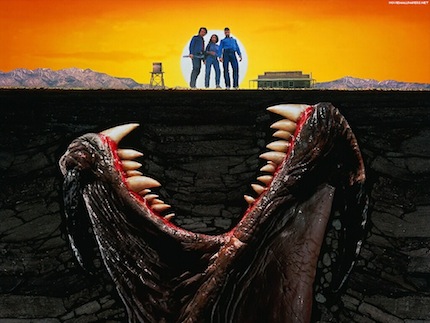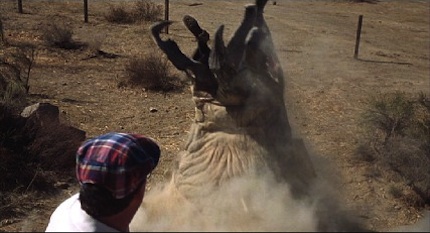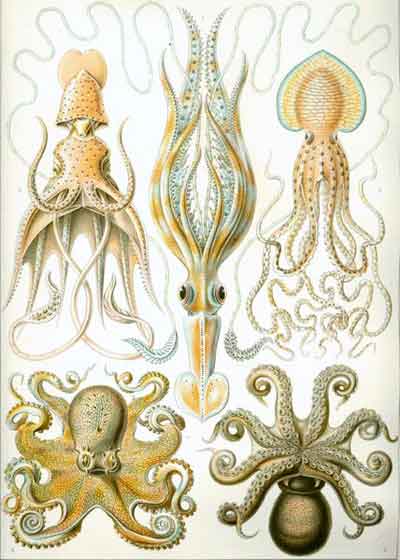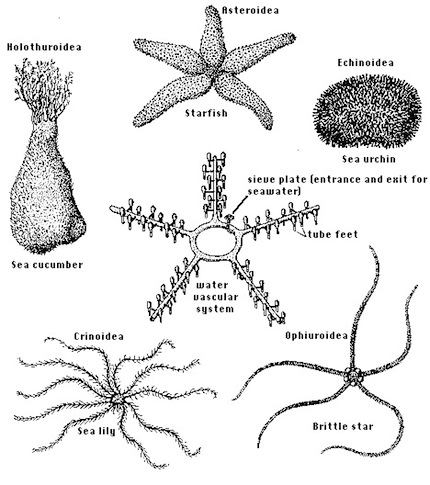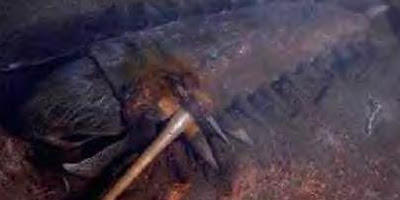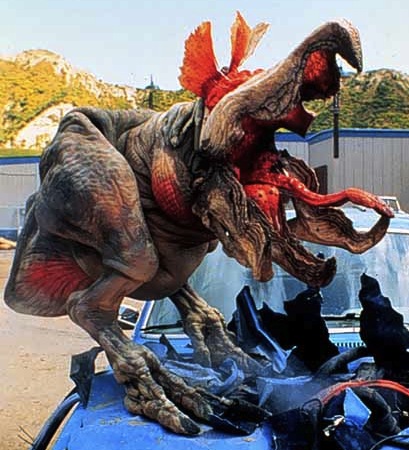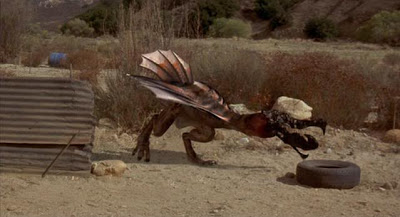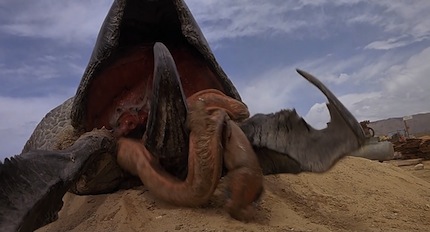 Animalia Bilateria Cephalopoda Coleoidea Sepioida Vermiformidae Caederus Americana a.k.a. “Graboid”
Animalia Bilateria Cephalopoda Coleoidea Sepioida Vermiformidae Caederus Americana a.k.a. “Graboid”
The Tremors film series is one of the few inhuman monsters of the 90s to gain lasting appeal and spawn a decent franchise.
Part of this, of course, stems from the relative uniqueness of the monsters.
In film, there were only two other giant underground worms which ate people before the Graboids appeared: Dune (1984) and the Mystery Science Theater worthy Jaws rip-off Blood Beach (1980).
Neither of which really do what the Graboid does.
So let’s take it apart, bit by bit, and see what makes it tick.
Symbolism
On the surface, the Graboid’s symbolism is simple.
It’s shape renders it far removed from human compassion and understanding. It is not something that can be sympathized with easily. Its behavior and habitat, however, have more to say. Living underground and attacking from there, it manages to demonize and make fearful the mundane. As Jaws kept swimmers from the beaches and Psycho made others lock their bathroom doors, Tremors turned loose soil into something that harbored death.
Their ambush hunting method also ties into one of the most primal of fears: that of being hunted and eaten. The hunting style of the Graboids calls to mind many other ambush predators. Unlike wolves which run down there prey, their nearest modern land equivalent predators are big cats like leopards and tigers. Suddenly, out of the bush, they strike and kill their prey, but for the Graboid, their “bush” is the earth itself.
People often nickname Graboids and similar creations “land sharks,” and to a degree the behavior holds true. The Great White shark, while hunting seals off South Africa’s coast, are known to breach in a manner similar to what many Graboids do to nab their prey. Their second feeding method, sucking down prey, also comes off like a shark attack to us land-lubbers: they grab hold and pull prey that lies on the surface into the murky depths.
They hit an effective trinity of fear for us humans: They are out to eat us; they could be anywhere; and they will strike without warning. It’s like the perfect under-the-bed boogieman let loose in the dirt.
Biology
One of the more memorable lines of dialogue, at least for paleontologists and fossil enthusiasts (who generally love the film), has the geology student, Rhonda LeBeck (played by Finn Carter) start speculating on the Graboids by saying this: “There’s nothing like them in the fossil record. I’m sure. Okay, so they predate the fossil record.”
At this point, any scientist watching the movie with you will either sigh or giggle. Despite this flub, the film’s young scientist is actually quite refreshing. In this film, the scientific method permeates the film as part of the characters thinking process. They observe, make hypothesis and test them. Sure, a failed test may get them killed, but that’s Hollywood for you.
Later on, in the second film of the series, fossils are discovered of a Graboid spike, but dated to the Precambrian era—which just raises the question “what was it eating since all other life forms were water bound slims or sea pens?”
So unless the biology talked about in Gigantis: the Fire Monster, where monsters literally spawned from the flames of the earth’s crust, it would have had nothing to feed on.
So where did the Graboids come from?
In the fossil record we have, only three groups of animals come even close to being like Graboids, and all of them are aquatic.
First, there’s cephalopods (squids, octopuses and Cuttlefish), but the tentacles are all wrong.
The other organisms are from the Cambrian period.
Called Radiodonta, these creatures range in size from four centimeters (1.4 inches) to almost a meter (three feet) in length, and had mouths separated from their feeding tentacles. They ranged from the Cambrian to the Devonian and were quite weird. They had eyes (Opabinia had five, Anamalocaris had its pair on stalks), and used their tentacles to bring food to their mouths like elephants do.
Sadly, these critters had no hard parts like the Graboids do and have a very poor fossil record because of it.
Finally, there are echinoderms (starfish, sea urchins and sea slugs).
The sea slug in of particular note: despite feeding on the leftovers of the sea floor; it has the tubular body and mouth full of internal tentacles makes them sort of look like Graboids.
Others tend to look like excrement—to the point where one Caribbean species is commonly known as Donkey Dung”.
But even given their primitive ancestry, they probably only began their current life style recently in geologic terms, mostly because they need large land animals and sandy or soft soil to move around in.
Where a creature evolves counts for a lot.
From the movies, we know they are found in the United States, Mexico and Argentina. This leads to the conclusion that they primarily evolved in Mexico and moved North and South from there. Their strange reproductive cycle helps spread them and allows the population to be staggered.
 |
| Graboid egg |
Starting as an egg, they hatch into smaller, 2 ridged versions of the giant worms.
In the fourth film in the series, they were shown attacking human sized prey items like ravenous movie piranha.
Real animals don’t behave like that unless stressed or starved. They were probably both, poor devils.
They then move to the classic Graboid stage and, once acquiring enough food, metamorphose into the next stage: spawning three “Shriekers”. These meter-tall bipeds are deaf, but have infra-red vision and spawn more Shriekers by eating enough and vomiting up a new one.
This, biologically, is where things get weird, because after the worm stages, it looks at least like they have internal structures similar to if not actual bones supporting themselves.
Which actually makes sense given their size and original habitat underground; they’d need strong internal structures as well as a tough outer layer to move as freely as they do. Which then makes their identification among Echinoderms even likely than the other options.
Finally, after a few days, they molt their skin and become “Ass Blasters”.
These wonderfully named animals use a violent chemical reaction to launch themselves into the air and gliding off to new locations to lay eggs (and eating along the way to fuel said chemical reaction, a process which leaves them quite vulnerable).
Speaking of vulnerability, as animals, they are actually quite fragile.
Not physically: given the number of bullets that bounce off their beaks, skim off their sides and what it takes to kill one in a single shot, saying that would be rather silly.
Their weaknesses are in their breeding cycle and the limits of their habitat.
They can’t really live in areas without loose soil and wet environments would drown them quickly. Further, their egg germination time is atrociously long. Their short life cycle outside the egg and long time in it (up to a hundred years based on the fourth film in the series), reduces their ability to proliferate and leaves them at an evolutionary disadvantage, unable to adapt to changes in their environment.
Other problems include their smell. Graboids smell bad. Really, really bad. This easily can put off sharp nosed prey (or even just Sheep) items if they approach from the wrong direction. This is counterbalanced by their ability to wait out prey and resistance to both starvation and dehydration. They likely get all the water they need from their prey and have extremely efficient digestive tracts.
From what we see of their hunting habits in the first film, they will usually, when not ravenous or angry, open their mouths underground to create a sinkhole for prey to enter, wrapping them up in their tentacles before dragging them into the mouth. As they gain experience, they can do this with greater swiftness, though they will alter their hunting patterns to suit new situations, but they are still reactive, simple organisms for the most part. It is rare to see these creatures plan something out or use actual team work.
The later stages of the Graboid tend to be a lot dumber, attacking anything which meets their parameters as good, which consists of anything which they can detect in their parameters for food, be it something making movement noises or being warm.
Anything.
Intelligence wise, they probably rate around that of amphibians or even advanced reptiles like crocodilians. A far fry cry from cephalopods, which can be as smart as canines. They rely more on instinct than on thought. The trap set up towards the end of the original film is a programmed response rather than innovation. It takes a lot of stupid to attack warm radiators and radios.
Or, as a character said in a later film about their second metamorphic stage: “They’re so smart because they’re so dumb.”
They only succeed against the heroes due to their unknown parameters. Once they are known, as demonstrated in the third film, they can be dealt with conventionally.
That is probably their most unique features and what makes them truly like animals.


































































































